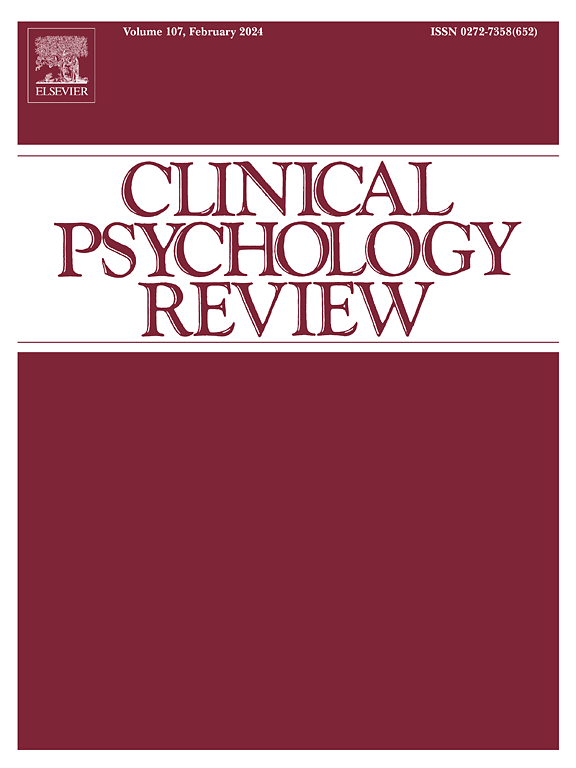过去30年认知行为治疗焦虑症的随机对照研究的效应量
IF 12.2
1区 心理学
Q1 PSYCHOLOGY, CLINICAL
引用次数: 0
摘要
认知行为疗法(CBT)是一种有效的治疗焦虑症的方法,在过去30年进行的许多随机对照试验(rct)中得到了证明。目的研究CBT效应量随时间的变化,检验出版年份是否为显著调节因子。数据来源我们汇集了三个先前发表的荟萃分析的研究,并检索了三个电子数据库(PubMed, PsychINFO, Web of Science),以确定2022年2月1日至2025年1月24日期间发表的任何其他研究。最终的分析包括49项研究,共有3645名参与者。研究选择:我们选择比较CBT治疗焦虑症与心理或药物控制条件的随机对照试验。数据提取两个独立的评分者使用预定义的数据字段,包括研究质量指标。所有比较CBT与对照组的随机对照试验的平均效应值显示,Hedges' g为0.51,95% CI[0.40, 0.62],诊断组之间的效应值存在显著差异。非受控的前后效应大小计算显示CBT的影响很大,Hedges' g = 1.18, 95% CI[1.01, 1.34],而对照条件的影响中等,Hedges' g = 0.59, 95% CI[0.47, 0.70]。对出版年份效应量的线性元回归(Hedges g)显示,与过去30年的对照条件相比,效应量没有显著变化(B = - 0.008, SE = 0.006, t(47) = - 1.18, p = 0.24)。结论虽然CBT是一种有效的治疗焦虑症的方法,但在过去的30年里,其效应量并没有增加。这就需要对治疗改变的过程进行研究,以提高CBT的疗效。本文章由计算机程序翻译,如有差异,请以英文原文为准。
Effect sizes of randomized-controlled studies of cognitive behavioral therapy for anxiety disorders over the past 30 years
Background
Cognitive-behavioral therapy (CBT) is an effective treatment for the range of anxiety disorders as demonstrated in many randomized controlled trials (RCTs) conducted over the past 30 years.
Objective
To examine the change of CBT effect sizes over time, we tested whether publication year was a significant moderator.
Data sources
We pooled studies from three previously published meta-analyses and searched three electronic databases (PubMed, PsychINFO, Web of Science) to identify any additional studies published from February 1, 2022 to January 24, 2025. The final analysis included 49 studies comprising a total of 3645 participants.
Study selection
We selected RCTs comparing CBT for anxiety disorders with psychological or pill control conditions.
Data extraction
Two independent raters used predefined data fields, including study quality indicators.
Data synthesis
The mean effect size of all RCTs comparing CBT vs. controls revealed a Hedges' g of 0.51, 95 % CI [0.40, 0.62], with significant differences in effect sizes between the diagnostic groups. Uncontrolled pre-post effect size calculations revealed a large effect for CBT, Hedges' g = 1.18, 95 % CI [1.01, 1.34], and a medium effect for the control conditions, Hedges' g = 0.59, 95 % CI [0.47, 0.70]. A linear meta-regression of publication year on effect sizes (Hedges g) showed no significant change in effect sizes as compared to the control conditions over the span of the last 30 years (B = −0.008, SE = 0.006, t(47) = −1.18, p = 0.24).
Conclusion
Although CBT is an effective treatment for anxiety disorders, the effect sizes did not increase over the last 3 decades. This calls for studies on the processes of treatment change to improve the efficacy of CBT.
求助全文
通过发布文献求助,成功后即可免费获取论文全文。
去求助
来源期刊

Clinical Psychology Review
PSYCHOLOGY, CLINICAL-
CiteScore
23.10
自引率
1.60%
发文量
65
期刊介绍:
Clinical Psychology Review serves as a platform for substantial reviews addressing pertinent topics in clinical psychology. Encompassing a spectrum of issues, from psychopathology to behavior therapy, cognition to cognitive therapies, behavioral medicine to community mental health, assessment, and child development, the journal seeks cutting-edge papers that significantly contribute to advancing the science and/or practice of clinical psychology.
While maintaining a primary focus on topics directly related to clinical psychology, the journal occasionally features reviews on psychophysiology, learning therapy, experimental psychopathology, and social psychology, provided they demonstrate a clear connection to research or practice in clinical psychology. Integrative literature reviews and summaries of innovative ongoing clinical research programs find a place within its pages. However, reports on individual research studies and theoretical treatises or clinical guides lacking an empirical base are deemed inappropriate for publication.
 求助内容:
求助内容: 应助结果提醒方式:
应助结果提醒方式:


